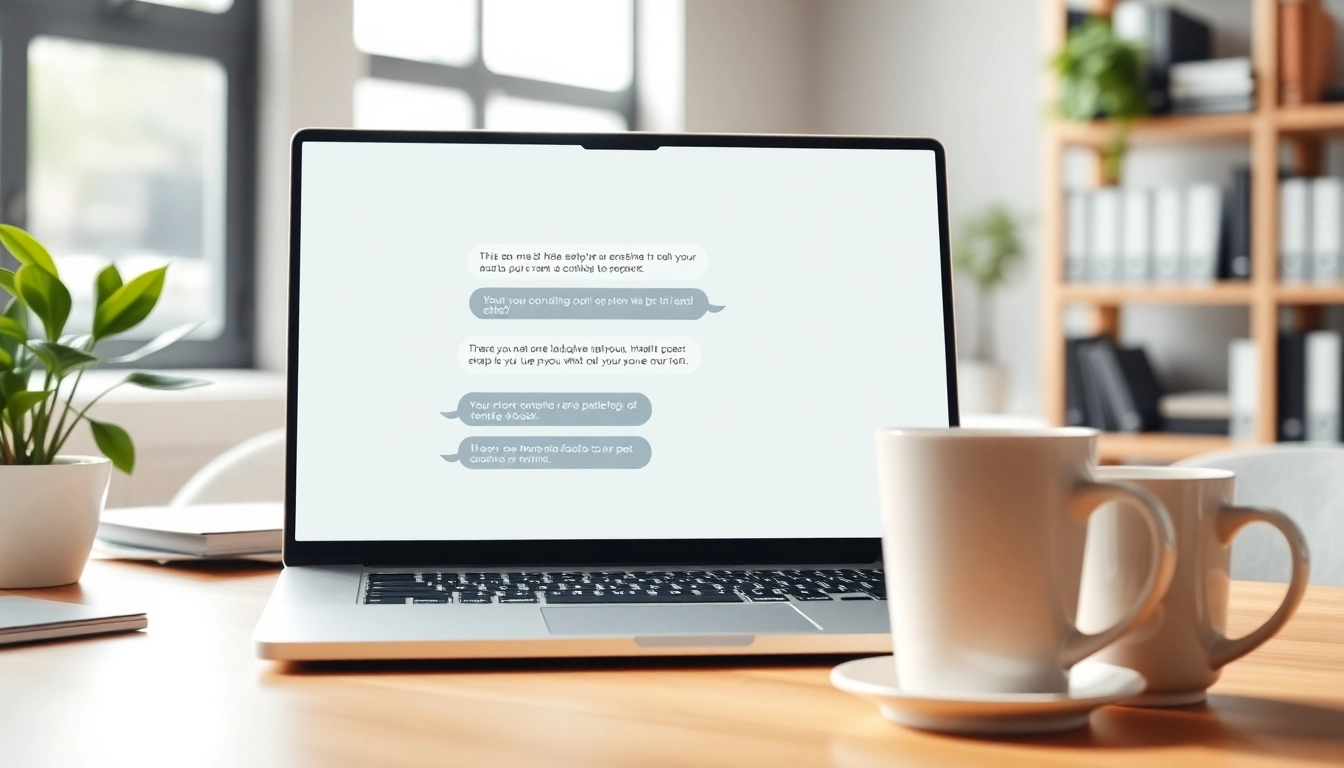Understanding the Role of a Website Chatbot
What is a Website Chatbot?
A website chatbot is an artificial intelligence (AI) program designed to simulate conversation with human users, particularly over the Internet. Unlike traditional customer service methods, which often involve long wait times and often frustrating interactions, chatbots provide immediate assistance and guidance 24/7. They utilize natural language processing (NLP) to understand user inquiries, allowing them to engage in meaningful dialogues. With the use of machine learning capabilities, these chatbots can continuously improve their interactions based on past conversations, making them an integral tool for businesses seeking to enhance customer engagement. For many organizations, integrating a website chatbot serves as a transformative strategy, not just for customer service, but also for marketing and sales endeavors.
Benefits of Using a Website Chatbot
The implementation of chatbots on websites offers a myriad of benefits that can significantly enhance business efficiency and customer satisfaction. These benefits include:
- 24/7 Availability: Chatbots never require downtime, offering instant support and answers to customer queries any time of the day or night.
- Cost Efficiency: By automating routine support tasks, businesses can save on costs associated with hiring and training staff.
- Improved User Engagement: Chatbots can initiate conversations, engage users, and guide them to relevant information, enhancing the overall user experience.
- Data Collection: Chatbots can gather user data, providing insights into customer behavior and preferences that can inform marketing strategies.
- Scalability: Chatbots can handle multiple interactions simultaneously, making them an ideal solution for businesses experiencing growth.
Common Use Cases for Chatbots
There are various scenarios in which website chatbots can be beneficial, including:
- Customer Service: Providing answers to frequently asked questions, troubleshooting issues, and guiding users to resources or support agents.
- Lead Generation: Qualifying leads through conversational interactions and collecting contact information for follow-ups.
- E-commerce Guidance: Helping customers find products, providing recommendations, and facilitating purchases directly through the chat interface.
- Appointment Scheduling: Automating the process of booking appointments or reservations, thus reducing administrative burdens.
- User Onboarding: Guiding new users through the features of a product or service, ensuring they have a seamless start.
Designing an Effective Chatbot Experience
Key Features to Incorporate
To create a successful chatbot experience, several key features should be considered:
- Natural Language Processing: This technology allows the chatbot to understand user queries in a conversational tone, making the interaction more human-like.
- Personalization: Tailoring responses based on user data or previous interactions can significantly enhance engagement.
- Integration with CRM Systems: Enabling the chatbot to pull and deliver customer information seamlessly enhances service quality and responsiveness.
- Multilingual Support: In today’s global marketplace, offering chatbot services in multiple languages can widen your audience reach.
- Rich Messaging Capabilities: Incorporating images, videos, or quick reply buttons can make conversations more interactive and keep users engaged.
Best Practices for User Interface Design
An effective user interface (UI) design is crucial for ensuring users have a positive experience while interacting with a chatbot. Here are best practices to follow:
- Simplicity: Maintain a clean, user-friendly interface that facilitates easy navigation and interaction.
- Clear Visual Cues: Use icons, buttons, and prompts that guide users intuitively through the conversation.
- Brand Consistency: Ensure the chatbot’s appearance and tone are aligned with the overall branding strategy of the business.
- Feedback Mechanisms: Incorporate options for users to provide feedback on their experience to help in improving the chatbot’s performance.
- Failure Management: Design fallback responses for when the bot cannot understand a user’s input, offering alternatives or escalation to human support.
Tailoring Conversations to User Needs
To ensure that the chatbot meets user expectations, it is essential to tailor conversations effectively. This can be achieved through:
- User Segmentation: Identify different user groups and customize interactions accordingly.
- Contextual Awareness: Equip the chatbot to understand the context of the conversation for more relevant responses.
- Goal-Oriented Dialogues: Define clear objectives for interactions based around user goals and needs.
- Adaptive Learning: Utilize machine learning to adapt responses based on user behavior and feedback over time.
- Content Richness: Provide valuable information, suggestions, and support that resonate with user queries and interests.
Implementing Your Website Chatbot
Steps to Set Up Your Chatbot
Setting up a website chatbot involves a systematic approach. Here are the essential steps to implement your chatbot:
- Define Objectives: Clearly outline what you want to achieve with the chatbot, whether it’s customer support, lead generation, or engagement.
- Select a Platform: Choose a chatbot platform that suits your needs, such as dedicated software or chatbot frameworks like Microsoft Bot Framework or Google Dialogflow.
- Design Conversation Flows: Plan and design the typical conversations users might engage in, mapping out various scenarios and responses.
- Develop the Chatbot: Use the chosen platform to develop the bot, implementing features and integrating technology as necessary.
- Test Thoroughly: Before launching, conduct extensive testing to identify and rectify any issues that might hinder user interaction.
- Launch: Go live with your chatbot, ensuring it is easily accessible on your website.
Integrating with Existing Systems
For a chatbot to provide maximum value, integrating it with existing systems is vital. This can involve:
- CRM Integration: Connecting the chatbot to customer relationship management tools allows it to access user data and personalize interactions.
- Support Ticketing Systems: Enabling the bot to create and manage support tickets improves the efficiency of customer support.
- E-commerce Platforms: Integrating your chatbot with your e-commerce engine allows it to assist customers with product inquiries, orders, and payment processing.
- Analytics Tools: Utilize analytics tools to monitor chatbot performance and user interactions, helping you gain insights for further enhancement.
Training Your Chatbot for Better Performance
The training of your chatbot is an ongoing process that greatly influences its efficacy. Here are key practices for effective training:
- Use Real Interaction Data: Analyze past user interactions to inform training protocols and enhance the chatbot’s understanding of common inquiries.
- Regular Updates: Continuously update the knowledge base of the chatbot to include the latest information and best practices.
- Stakeholder Feedback: Gather insights from both users and customer service representatives to understand common pain points and areas for improvement.
- Iterative Testing: Regularly conduct performance testing to identify weaknesses in responses or interactions and work on those areas diligently.
Measuring the Success of Your Chatbot
Key Performance Indicators (KPIs) for Chatbots
To evaluate the effectiveness of a website chatbot, businesses should track specific KPIs. These include:
- Response Quality: Measure how accurately the chatbot responds to user inquiries and how helpful those responses are.
- User Engagement: Track the frequency of interactions, session duration, and engagement rates to understand user interest.
- Conversion Rates: Analyze how well the chatbot contributes to achieving specific business goals, like sales or lead generation.
- Customer Satisfaction Scores: Collect feedback through user ratings or surveys to gauge satisfaction levels with the chatbot experience.
- Escalation Rates: Monitor how often users need to escalate issues to a human representative, which can signal areas where the chatbot may be lacking.
Collecting and Analyzing User Feedback
In order to continuously improve the chatbot experience, it is important to establish robust mechanisms for collecting user feedback. Suggestions may include:
- Feedback Prompt Post-Interaction: Offer users an opportunity to rate their experience immediately following their interaction with the chatbot.
- Periodic Surveys: Conduct surveys at regular intervals to gather more comprehensive insights into the chatbot’s performance and user expectations.
- Review Common Queries: Examine the types of inquiries that often lead to frustration or require escalation to make adjustments accordingly.
- Focus Groups: Utilize focus groups composed of users to gain qualitative insights in a controlled setting, allowing for a deeper understanding of user perceptions.
Continuous Improvement Strategies
Continuous improvement is crucial to maintaining a high-performing chatbot. Consider the following strategies:
- Regular Updates and Maintenance: Schedule regular updates to the bot’s database, ensuring responses are current and relevant.
- Innovation Integration: Stay updated on the latest in AI technologies and consider integrating new functionalities that enhance user experiences.
- Platform Performance Review: Regularly assess the performance of the underlying platform used to host the chatbot, ensuring it operates seamlessly.
- Competitive Benchmarking: Analyze competitor chatbots to identify best practices and areas for differentiation in your own service.
Future Trends in Website Chatbots
AI Enhancements in Chatbots
As AI technology continues to evolve, its integration into chatbots will lead to even more sophisticated functionalities. Key enhancements to look forward to include:
- Emotion Recognition: Future chatbots may be equipped with the capability to detect emotions through text sentiment analysis, allowing for responses that are more empathetic and human-like.
- Contextual Understanding: Improved capabilities in understanding context will allow chatbots to manage multi-turn conversations more effectively and maintain context over longer user interactions.
- Predictive Analytics: By analyzing user data, chatbots could predict inquiries and offer proactive support, significantly enhancing the user experience.
The Growth of Multi-Channel Chatbot Experiences
The future will likely see a rise in multi-channel chatbot interfaces that can operate across various platforms such as websites, social media, and messaging apps. Implementing omni-channel solutions can offer users a seamless transition between devices and platforms, maintaining context and continuity in conversations. This shift will allow businesses to reach their customers wherever they are, improving engagement and satisfaction significantly.
Ethical Considerations and User Privacy
As chatbots grow in popularity, ethical considerations and user privacy will become increasingly significant. Businesses must ensure:
- Data Security: Implement robust security measures to protect user data and maintain confidentiality.
- Transparency: Clearly communicate to users how their data will be used and provide options for data management.
- Ethical AI Practices: Commitment to ethical standards in AI usage will be critical to building trust among users and ensuring compliance with evolving regulations.














Leave a Reply